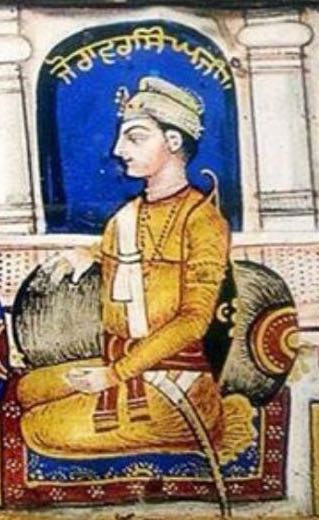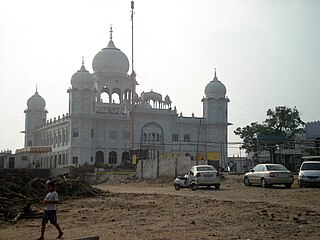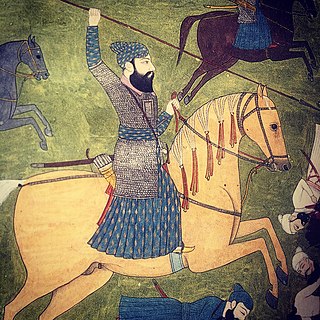
Guru Gobind Singh was the tenth and last human Sikh Guru. He was a warrior, poet, and philosopher. In 1675, at the age of nine he was formally installed as the leader of the Sikhs after his father Guru Tegh Bahadur was executed by Emperor Aurangzeb. His father was the ninth Sikh Guru. His four biological sons died during his lifetime – two in battle and two executed by the Mughal governor Wazir Khan.

Guru Tegh Bahadur was the ninth of ten gurus who founded the Sikh religion and was the leader of Sikhs from 1665 until his beheading in 1675. He was born in Amritsar, Punjab, India in 1621 and was the youngest son of Guru Hargobind, the sixth Sikh guru. Considered a principled and fearless warrior, he was a learned spiritual scholar and a poet whose 115 hymns are included in the Guru Granth Sahib, which is the main text of Sikhism.
Dal Khalsa was the name of the combined military forces of 11 Sikh misls that operated in the 18th century (1748–1799) in the Punjab region. It was established by Nawab Kapur Singh in late 1740s.

Bhai Mani Singh was an 18th-century Sikh scholar and martyr. He was a childhood companion of Guru Gobind Singh and took the vows of Sikhism when the Guru inaugurated the Khalsa in March 1699. Soon after that, the Guru sent him to Amritsar to take charge of Harmandir Sahib, which had been without a custodian since 1696. He took control and steered the course of Sikh destiny at a critical stage in Sikh history. He was also a teacher of the Gianian Bunga, later becoming known as the "Amritsari Taksal", currently located in Sato Ki Gali.

Zorawar Singh, alternatively spelt as Jorawar Singh, was a son of Guru Gobind Singh who was executed in the court of Wazir Khan, the Mughal Governor of Sirhind.
Bhai Bachittar Singh , often known with the honorific "Shaheed" (martyr), was a Sikh hero and a general of Guru Gobind Singh. His father was Bhai Mani Singh and he came from Alipur Riyasat Multan.

Nada Sahib is a Sikh gurudwara in the Panchkula district of the Indian state of Haryana. Situated on the banks of the Ghaggar-Hakra River in the Sivalik Hills of Panchkula, it is the site where Guru Gobind Singh Ji halted while travelling from Paonta Sahib to Anandpur Sahib after the Battle of Bhangani in 1688.
The Battle of Bhangani was fought between Guru Gobind Singh's army and Bhim Chand (Kahlur) of Bilaspur on 18 September 1686 or 1688, at Bhangani near Paonta Sahib. An alliance of Rajput Rajas of the Shivalik Hills participated in the engagement on behalf of Bhim Chand of Bilaspur State's side, including the states of Garhwal and Kangra. It was the first battle Guru Gobind Singh, the tenth Sikh Guru, fought at the age of 19.

The Battle of Nadaun, alternatively known as the Hussaini Yudh, was fought at Nadaun, between Raja Bhim Chand of Bilaspur (Kahlur) and the Mughals under Alif Khan. Bhim Chand was supported by Guru Gobind Singh and the Mughals were supported by other hill chieftains, notably Kirpal Chand from Kangra and Dayal Chand from Bijharwal. Bhim Chand and some hill chieftains, after conclusion of Battle of Bhangani had refused to pay tribute to the Mughal emperor which led to the battle at Nadaun. The battle resulted in the victory of Bilaspur State and Sikh alliance.
The Battle of Anandpur was fought at Anandpur, between the armies of the Sikh Guru Gobind Singh and the Mughal forces aided by the Nawab of Bahawalpur state, Rajas of the Sivalik Hills.

The second siege of Anandpur, also known as the second battle of Anandpur (1704), was a siege at Anandpur, between Sikhs and the Mughal governors, dispatched by Aurangzeb, Wazir Khan, Dilwaar Kahn and Zaberdast Khan, and aided by the vassal Rajas of the Sivalik Hills which lasted from May 1704 to 19 December 1704.

Baba Jiwan Singh was a Sikh general and companion of Guru Gobind Singh.

Banda Singh Bahadur, was a Sikh warrior and a general of the Khalsa Army. At age 15, he left home to become an ascetic, and was given the name Madho Das Bairagi. He established a monastery at Nānded, on the bank of the river Godāvarī. In 1707, Guru Gobind Singh accepted an invitation to meet Mughal Emperor Bahadur Shah I in southern India, he visited Banda Singh Bahadur in 1708. Banda became disciple of Guru Gobind Singh and was given a new name, Gurbaksh Singh(as written in Mahan Kosh), after the baptism ceremony. He is popularly known as Banda Singh Bahadur. He was given five arrows by the Guru as a blessing for the battles ahead. He came to Khanda, Sonipat and assembled a fighting force and led the struggle against the Mughal Empire.
The first siege of Anandpur was a thirty-five-day-long siege at Anandpur led by the Rajas of the Sivalik Hills and the Gujar and Ranghar tribesmen against the armies of the Sikh under Guru Gobind Singh.
The Battle of Guler was fought between forces led by Sikh Guru Gobind Singh and Mughal forces, aided by the Rajas of the Sivalik Hills.

Bhim Chand was the Rajput King of Bilaspur state and Anandpur Sahib fell under his territorial area. He launched his first expedition against Guru Gobind Singh in 1682. In 1686 he conflicted with the armies of Guru Gobind Singh and his disciples in Battle of Bhangani. In 1692, Bhim Chand fought Battle of Nadaun against Mughals and came out victorious.
Shaheed BhaiSangat Singh Bangesar was a Sikh warrior, general and martyr in the Battle of Chamkaur.

The Hill States–Sikh wars, also known as the Sikh–Pahari Raja wars, was a set of battles and conflicts fought by the Sikhs and the rajas (kings) of the Hill States located in the Sivalik Hills.
Uday Singh was a Sikh warrior during the period of Guru Gobind Singh.
The Battle of Talwara was fought in 1770 by the Sikh forces led by Jassa Singh Ramgarhia and the Kangra forces led by Raja Ghamand Chand.












